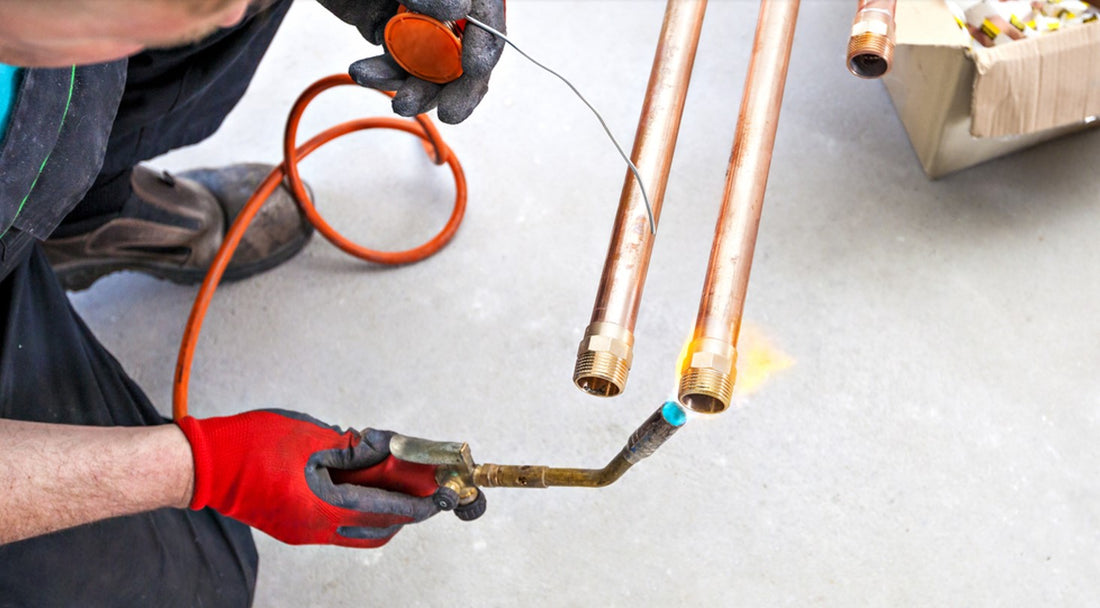Brazing is using heat to join two metals together by using a filling material to join the two metal pieces together. It is usually done in welding without liquid, gas, or electricity.
Here’s how it works. Molten filler metal is brushed onto one surface and melted on another until plating forms on both surfaces, causing them to become bonded together.
The way you braze depends on the material that you’re brazing. One common material that’s often brazed is copper, for which you need the right brazing rod – a copper brazing rod.
This article will explain exactly what a copper brazing rod is and how to properly braze copper for your next welding project.
What Is a Copper Brazing Rod?
A copper brazing rod is a brazing rod used to join copper metal. The rod itself isn’t necessarily made out of all copper.
Brazed joints are used for various applications where joint strength is imperative. Typically, the main reason that most people braze copper is to braze copper pipes for plumbing. However, there are several other reasons that you may want to braze copper. These applications may include:
- Refrigeration
- HVAC
- High-pressure airlines
Let’s take a look at what you need for any brazing project.
Why Use a Copper Brazing Rod to Braze Copper?
To join your metals, you need a brazing rod. Brazing rods come in various materials, such as aluminum and copper. Joining different materials requires brazing rods made of those different materials.
You should avoid using certain brazing alloy materials with dissimilar metals, which may produce adverse effects. For example, do not use phosphorus brazing rods (with a large amount of phosphor) for copper pipes.
A copper brazing rod is ideal for joining two copper metal pieces together. However, you can also join copper with other materials, such as stainless steel. Copper brazing rods are not 100% copper – they are typically made from a combination of copper, zinc, and sometimes a small amount of silver.
With this new knowledge on copper brazing rods, it’s time to learn how to use your copper brazing rod.

How to Join Copper With a Copper Brazing Rod
You can complete your copper joining in just three easy steps:
- Prepare the joint.
- Braze the joints.
- Inspect and touch up the finished product.
However, you must wear the right safety equipment and protective gear before doing any work. This means wearing gloves, a jacket, goggles, and any other gear you need to feel safe.
Let’s jump right into what each of these steps entails.
1. Prepare the joints
Make sure you have your protective gear on at this point.
Before jumping into using your copper brazing rod, you should make sure to inspect the joints that you’re starting with. This involves cleaning and wiping the metal and ensuring there aren’t any knicks or scratches.
If there are any issues with the metal before you start, addressing them is essential, as they may appear in the final product.
2. Braze the joints
Now that your pieces are ready to be joined, it’s time to add heat.
You’re going to heat your pieces with the help of a torch, which is one of the most precise heating methods. The type of torch you use will depend on the type and size of the pieces you’re joining. For bigger pieces, you might want to use an acetylene torch specially made for brazing. For smaller pipes, you can get away with a propane torch.
With your torch set up, you’re now prepared to heat your pieces to begin the brazing process. The heat should be hot enough to melt the joint side of each piece. Once the pieces are heated, align your copper brazing rod into place until it melts into place. Let your newly jointed piece cool down before inspecting.
3. Inspect and touch up the finished product
Once your piece is cool, make sure everything looks as it should. You can also get a wire brush to remove any scaling you may see on the surface.
If you believe any adjustments need to be made to the joint piece, make them immediately for the best results.
The Verdict: Are Copper Brazing Rods Right for You?
If you’re looking to join copper pipes or copper pieces for any other purpose, you should consider using a copper brazing rod. While they may not be as lightweight as aluminum brazing rods, they’ll leave you with a polished finished result.
As with other brazing rods, caution is essential when brazing your materials together. Otherwise, you run the risk of seriously injuring yourself.

